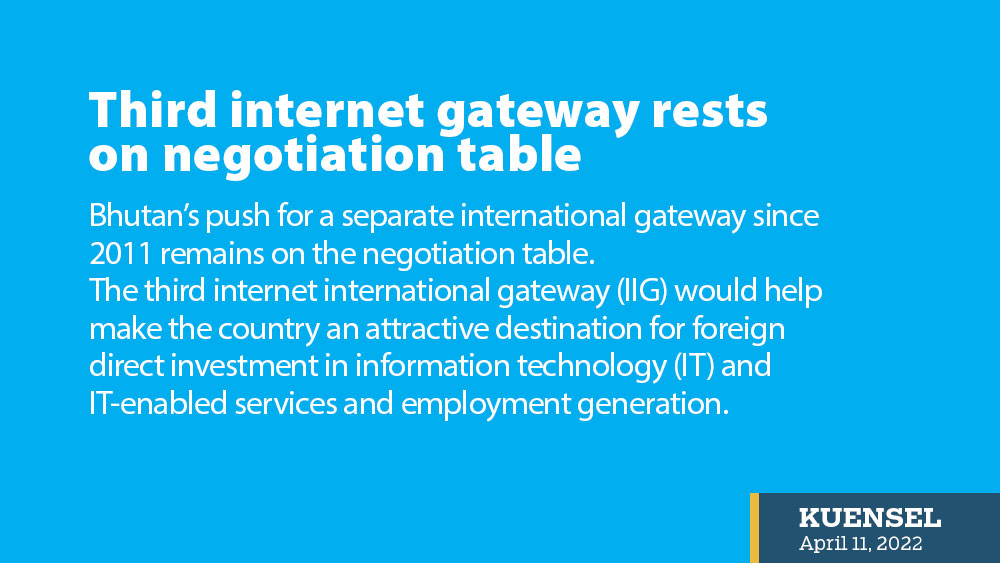Phub Dem
Bhutan’s push for a separate international gateway since 2011 remains on the negotiation table.
The third internet international gateway (IIG) would help make the country an attractive destination for foreign direct investment in information technology (IT) and IT-enabled services and employment generation.
However, the issues of redundancy, reliability, security and price remain major challenges to harnessing the power of ICT to the dreams of digital transformation.
After more than a decade, Bhutanese remain hopeful about the new connection.
Bangladesh has confirmed providing a 10 Gbps International Private Leased Circuit to Bhutan at a friendly rate of USD 3 per Mbps.
Those in the IT industry call the friendly rate offered by Bangladesh ‘unprecedented’ and are eagerly looking forward to positive negotiation and friendly rates from India.
Negotiations with Indian counterparts are ongoing.
A new link from Kuakata
The government is proposing the new link through the Gelephu-Agartala-Comilla-Kuakata-Singapore link. The route for the third IIG was finalised as Gelephu-Agartala, India-Comilla, Bangladesh-Kuakata, Bangladesh-Singapore.
According to officials with MoIC, Kuakata is the landing station for the SEA-ME-WE5 submarine cable, and Cox Bazar is the landing station for the SEA-ME-WE4 submarine cable.
The SEA-ME-WE 5 (SMW5) is a 20,000km submarine cable system connecting 17 countries through Points-of-Presence (POPs) from Singapore to the Middle East to France and Italy in Western Europe. The South East Asia-Middle East-West Europe 4 (SEA-ME-WE 4, SMW4) is an 18,800 km submarine cable providing the primary Internet backbone between South East Asia, the Indian subcontinent, the Middle East and Europe.
The officials say that Kuakata on SEA-ME-WE 5 submarine cable was proposed for the third gateway as it has more capacity than SEA-ME-WE-4. Besides, the internet and telephone service providers are currently using SEA-ME-WE-4 in their existing international links. “Connectivity through SEA-ME-WE-5 shall also enable redundancy in submarine cable connection.”
Although five International Long Distance (ILD) operators proposed support for implementing the third gateway during a conference meeting with the Department of Telecommunications, the rates offered were higher than the existing one.
It was learnt that Bhutan shared Bangladesh’s confirmation with the government of India, and requested their ILD operators to further bring down their costs so that the price for the full link is between USD 4 to USD 4.5.
Bhutan has three nationwide Internet Service Providers (ISPs) with international Internet gateways—Bhutan Telecom, Tashi Infocomm, and NANO. All of them pass through the Siliguri corridor in India. A single incident at Siliguri could trigger reliability issues for both primary and secondary connections to Bhutan.
Many recall the largest internet service provider Bhutan Telecom crashed out with no internet lines on May 21 last year. This is why establishing the third international gateway is essential for backup whenever the first and second gateways through Siliguri go down.
An IT expert Tshering Cigay Dorji said that a confirmation of a friendly rate like Bangladesh would provide the country with proper redundancy for the international internet backbone. As the new link is expected to improve reliability and might reduce the cost, he said it would be of immense help to Bhutan.
Tshering Norbu of NANO said that the new link would improve the reliability of international connectivity when outages occur on the current connection. “While Bangladesh offers a lower rate, connectivity along India to reach Bhutan carries a separate price.”
He said that the new link could address the congestion because when one of the international connectivity goes down, congestions often slow the Internet access.
“It comes as an additional cost to service providers, and it is uncertain whether the cost can come down with the third getaway,” he said.


